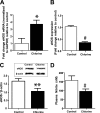Chlorine gas exposure causes systemic endothelial dysfunction by inhibiting endothelial nitric oxide synthase-dependent signaling
- PMID: 21131444
- PMCID: PMC3175567
- DOI: 10.1165/rcmb.2010-0151OC
Chlorine gas exposure causes systemic endothelial dysfunction by inhibiting endothelial nitric oxide synthase-dependent signaling
Abstract
Chlorine gas (Cl(2)) exposure during accidents or in the military setting results primarily in injury to the lungs. However, the potential for Cl(2) exposure to promote injury to the systemic vasculature leading to compromised vascular function has not been studied. We hypothesized that Cl(2) promotes extrapulmonary endothelial dysfunction characterized by a loss of endothelial nitric oxide synthase (eNOS)-derived signaling. Male Sprague Dawley rats were exposed to Cl(2) for 30 minutes, and eNOS-dependent vasodilation of aorta as a function of Cl(2) dose (0-400 ppm) and time after exposure (0-48 h) were determined. Exposure to Cl(2) (250-400 ppm) significantly inhibited eNOS-dependent vasodilation (stimulated by acetycholine) at 24 to 48 hours after exposure without affecting constriction responses to phenylephrine or vasodilation responses to an NO donor, suggesting decreased NO formation. Consistent with this hypothesis, eNOS protein expression was significantly decreased (∼ 60%) in aorta isolated from Cl(2)-exposed versus air-exposed rats. Moreover, inducible nitric oxide synthase (iNOS) mRNA was up-regulated in circulating leukocytes and aorta isolated 24 hours after Cl(2) exposure, suggesting stimulation of inflammation in the systemic vasculature. Despite decreased eNOS expression and activity, no changes in mean arterial blood pressure were observed. However, injection of 1400W, a selective inhibitor of iNOS, increased mean arterial blood pressure only in Cl(2)-exposed animals, suggesting that iNOS-derived NO compensates for decreased eNOS-derived NO. These results highlight the potential for Cl(2) exposure to promote postexposure systemic endothelial dysfunction via disruption of vascular NO homeostasis mechanisms.
Figures






Similar articles
-
Hypoglycaemia aggravates impaired endothelial-dependent vasodilation in diabetes by suppressing endothelial nitric oxide synthase activity and stimulating inducible nitric oxide synthase expression.Microvasc Res. 2023 Mar;146:104468. doi: 10.1016/j.mvr.2022.104468. Epub 2022 Dec 10. Microvasc Res. 2023. PMID: 36513147
-
Atorvastatin restores the impaired vascular endothelium-dependent relaxations mediated by nitric oxide and endothelium-derived hyperpolarizing factors but not hypotension in sepsis.J Cardiovasc Pharmacol. 2009 Dec;54(6):526-34. doi: 10.1097/FJC.0b013e3181bfafd6. J Cardiovasc Pharmacol. 2009. PMID: 19755915
-
Chlorine gas exposure disrupts nitric oxide homeostasis in the pulmonary vasculature.Toxicology. 2014 Jul 3;321:96-102. doi: 10.1016/j.tox.2014.04.005. Epub 2014 Apr 24. Toxicology. 2014. PMID: 24769334 Free PMC article.
-
Alterations in endothelial nitric oxide synthase activity and their relevance to blood pressure.Biochem Pharmacol. 2022 Nov;205:115256. doi: 10.1016/j.bcp.2022.115256. Epub 2022 Sep 19. Biochem Pharmacol. 2022. PMID: 36185001 Review.
-
Cytoprotective pathways in the vascular endothelium. Do they represent a viable therapeutic target?Vascul Pharmacol. 2016 Nov;86:41-52. doi: 10.1016/j.vph.2016.08.002. Epub 2016 Aug 9. Vascul Pharmacol. 2016. PMID: 27520362 Review.
Cited by
-
Targeted aerosolized delivery of ascorbate in the lungs of chlorine-exposed rats.J Aerosol Med Pulm Drug Deliv. 2012 Dec;25(6):333-41. doi: 10.1089/jamp.2011.0963. Epub 2012 Mar 6. J Aerosol Med Pulm Drug Deliv. 2012. PMID: 22393907 Free PMC article.
-
Respiratory syncytial virus infection increases chlorine-induced airway hyperresponsiveness.Am J Physiol Lung Cell Mol Physiol. 2015 Aug 1;309(3):L205-10. doi: 10.1152/ajplung.00159.2015. Epub 2015 Jun 12. Am J Physiol Lung Cell Mol Physiol. 2015. PMID: 26071553 Free PMC article.
-
Ascorbate and deferoxamine administration after chlorine exposure decrease mortality and lung injury in mice.Am J Respir Cell Mol Biol. 2011 Aug;45(2):386-92. doi: 10.1165/rcmb.2010-0432OC. Epub 2010 Dec 3. Am J Respir Cell Mol Biol. 2011. PMID: 21131440 Free PMC article.
-
Mechanisms and Treatment of Halogen Inhalation-Induced Pulmonary and Systemic Injuries in Pregnant Mice.Hypertension. 2017 Aug;70(2):390-400. doi: 10.1161/HYPERTENSIONAHA.117.09466. Epub 2017 Jun 12. Hypertension. 2017. PMID: 28607126 Free PMC article.
-
Chlorine inhalation-induced myocardial depression and failure.Physiol Rep. 2015 Jun;3(6):e12439. doi: 10.14814/phy2.12439. Physiol Rep. 2015. PMID: 26109193 Free PMC article.
References
-
- Evans RB. Chlorine: state of the art. Lung 2005;183:151–167. - PubMed
-
- Almagro Nievas D, Acuna Castillo R, Hernandez Jerez A, Robles Montes A. Investigation of an outbreak of acute respiratory illness due to exposure to chlorine gas in a public swimming pool [in Spanish]. Gac Sanit 2008;22:287–290. - PubMed
-
- Cevik Y, Onay M, Akmaz I, Sezigen S. Mass casualties from acute inhalation of chlorine gas. South Med J 2009;102:1209–1213. - PubMed
Publication types
MeSH terms
Substances
Grants and funding
LinkOut - more resources
Full Text Sources

